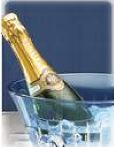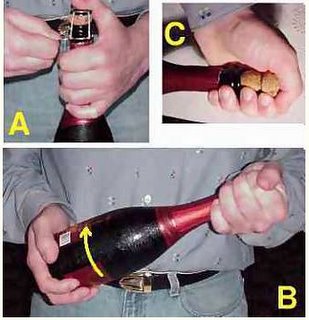Chilled to the bone (Gelée jusqu’à l’os)
 What do you do when you are in a fancy restaurant and your waiter opens your Crémant de Bourgogne all over your table, sending spurts of fizzy wine up and around you like a champion Daytona 500 racecar driver? Question his professionalism perhaps. And then ask the sommelier about how he can compensate you. It's a different story in a BYOW (Bring Your Own Wine) resto, like at Montreal's À l'os, for instance. In a place like that, you are your own sommelier. That means you are responsible for how the wine has been stored and prepared for serving. So when the server asks to uncork for you the sparkling wine that's sitting on your table he should really be offered danger pay. You've brought along this pressurized weapon with you; he can have no idea what he's getting himself into... SPLOOOSH!
What do you do when you are in a fancy restaurant and your waiter opens your Crémant de Bourgogne all over your table, sending spurts of fizzy wine up and around you like a champion Daytona 500 racecar driver? Question his professionalism perhaps. And then ask the sommelier about how he can compensate you. It's a different story in a BYOW (Bring Your Own Wine) resto, like at Montreal's À l'os, for instance. In a place like that, you are your own sommelier. That means you are responsible for how the wine has been stored and prepared for serving. So when the server asks to uncork for you the sparkling wine that's sitting on your table he should really be offered danger pay. You've brought along this pressurized weapon with you; he can have no idea what he's getting himself into... SPLOOOSH!
A loss at À l'os.
We should have seen it coming but we didn't. That's because À l'os has a reputation for being the wine enthusiast's premier BYO location. They want you to think that you can trust leaving it all up to them.
In some of Montreal's BYO venues, you might cringe when you see your eager server manhandling your Vouvray. You might wonder what on the menu is as sophisticated as the vintage you bought with you for dinner. Not so, at À l'os. But wait. Why is the are puddle of bubbly on their floor? Why did we almost lose a third of our prized wine? Just moments after stepping into the place for first time, I felt a bit betrayed. This isn't what the scene is supposed to be like in here. My friends nearest to where our waiter attempted to get a handle on our Prestige Moingeon Brut Crémant de Bourgogne, claim the bottle must've been volatile -- it was prepared for opening correctly and the technique the waiter used was sound: bottle cradled at an oblique angle, stopper gently nudged out of position, rendering only a faint release of air. By the time I looked over to the action, the bottle was perpendicular on the table and starting to froth uncontrollably. What a way to start the evening, I thought. And to boot, after all the commotion cleared, our table reset and the mess mopped up, we toasted our sparkling to find that it was already a shade too warm. DOIIING!
My friends nearest to where our waiter attempted to get a handle on our Prestige Moingeon Brut Crémant de Bourgogne, claim the bottle must've been volatile -- it was prepared for opening correctly and the technique the waiter used was sound: bottle cradled at an oblique angle, stopper gently nudged out of position, rendering only a faint release of air. By the time I looked over to the action, the bottle was perpendicular on the table and starting to froth uncontrollably. What a way to start the evening, I thought. And to boot, after all the commotion cleared, our table reset and the mess mopped up, we toasted our sparkling to find that it was already a shade too warm. DOIIING!
Light bulb! On a frigid night when it was minus 20 degrees Celsius (without the windchill factor), everything had seemed so thoroughly chilled to the bone. How could anything, let alone the wine that had been chilling in the fridge for several hours, get into the place with any warmth at all? I mean, picture it: There were the four of us, who had clamoured into the bistro rubbing our hands together; our drafty table, which was situated a little too close to an external door; the bottle of sparkling wine, which was icy cold to the touch.
But not cold enough. That heavy glass of the champagne bottle was hiding some wine that was above 7 degrees Celsius. And it was not happy! Violent, explosive, and too warm. On this night, who could've known? Not our waiter, who professionally handled the situation, and not us, still applying friction on the dinner napkins laid on our laps in a quest for warmth. But will we know better for next time, lest our brains freeze solid.
Let this be a lesson:
"Make Sure the Champagne is Cold ... Start off by chilling the bottle. The best serving temperature is around 45° Fahrenheit, that would be about 7° Celsius. If you put your hand on the bottle it should feel very cold not just cool. It's important to have a chilled liquid. Champagne that is too warm will foam and spill when you uncork the bottle. You'll lose some of the bubbly and make a mess." www.chiff.com/a/open-champagne.htm
"Temperature variations should be avoided and the bottles should not be moved. Before serving Champagne or Sparkling wine they need to be chilled. Not only will the champagne taste better cool, it will also foam less when opened. Ideally four to five hours of refrigeration is needed. Once opened it should be put on ice." www.thatsthespirit.com/en/drinks/articles/champagne.asp
"The procedure of opening a bottle of sparkling wine ... It is essential to keep the bottle oblique during the entire operation in order to prevent any possible spillage of wine because of the internal pressure. However this may happen in case the bottle is being opened when it is kept in vertical position or when its temperature is too warm or in case the bottle was energetically shaken." www.diwinetaste.com/dwt/en2002116.php







1 comment:
Hmmm-I have never tried my red and white chilling technique with a bubbly. I should specifically mention the potential for a volatile liquid pouring out of a freezing cold bottle. I usually chill my champagne in the fridge...
Post a Comment